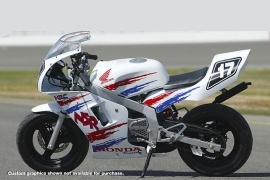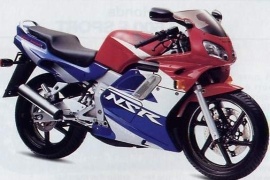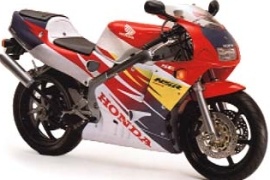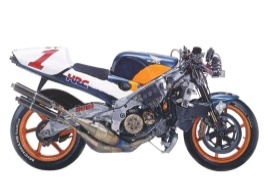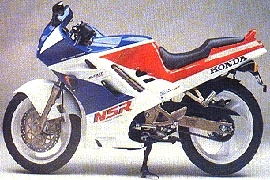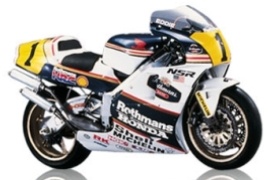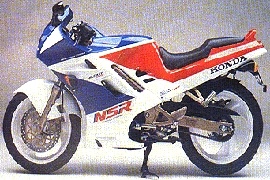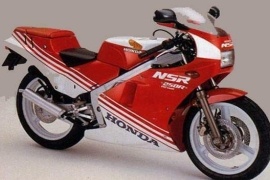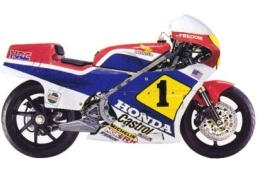HONDA NSR Models/Series Timeline, Specifications & Photos
First production year: 1984
The Honda NSR50 was a small engined motorcycle manufactured by Honda in a street-legal form in several countries, including Japan, France, Spain, and more. The bike was also offered off-road in Japan and the USA.
In the American market, the bike was offered for one year only in 2004, designated as NSR50R, while in Japan, the bike was delivered in 2004 and 2009 under the NSR Mini designation.
The NSR50R was one of the most commonly used motorcycles in minibike club road-racing in the USA but also with similar popularity worldwide. It was in the same class as the two-stroke 50cc road motorcycle, such as the Yamaha YSR50, and commonly classed with up to 110cc four-stroke motorcycles.
The bike was built around a twin-tube diamond-shaped steel frame with a 30 mm telescopic fork on the front and a steel swingarm with a single shock absorber on the rear, offering good suspension performance and handling.
As for braking performance, the NSR50R was equipped with a single disc with a two-piston hydraulic caliper on the front and a single-piston caliper with a disc on the rear, providing optimum stopping power.
The 2004 Honda NSR50R was powered by a 49cc two-stroke liquid-cooled single-cylinder engine fed by a carburetor, delivering an output power of seven hp with a maximum peak at 10,000 rpm.
The 2004 machine came equipped with three-spoke cast aluminum wheels, a single seat, a silver-finished frame, and a small windscreen. The model was designed for entry-level riders or those looking for a lightweight and agile track or sport riding machine.
The Honda NSR125 was a sports bike powered by a two-stroke single-cylinder engine with an RC-valve system that offered a redline at 11,000 rpm. The model was manufactured from 1988 to 2001, and the NSR125 designation was taken from the NSR500 MotoGP motorcycle.
There were two models in the NSR125 series, one designated as the JC20, produced from 1988 to 1994 with a dual round headlight design, and the JC22, manufactured from 1994 to 2001 with a fox eye headlight design.
The bike was designed and assembled in Rome, Italy, by Honda Italia Industriale. Grimeca was the company contracted to offer the frame, wheels, and brake assemblies, Girardoni provided the engine, Dell'Orto supplied the carburetor, Marzocchi showed the suspension, and Pagani delivered the instrument panel and lighting.
The 1996 Honda NSR125R came equipped with a full fairing, a one-piece dual seat with a passenger grab handle, a small windscreen, a double fox eye headlight design, and cast aluminum wheels with a six-spoke design.
A 35 mm telescopic fork was handling the bike's front suspension, and an adjustable Pro-Link shock absorber took care of the rear-end suspension, offering good performance and handling.
For brakes, the Honda NSR125R packed on the front a dual-piston caliper with a 316 mm disc and a dual-piston caliper with a 220 mm disc on the rear end, delivering strong stopping power.
In the engine department, the Honda NSR125R had a 124cc two-stroke single-cylinder engine with an output power of 12 hp at 9,500 rpm and 15 Nm (11 lb-ft) torque at 8,000 rpm.
In 1987, the Japanese maker launched the Honda NSR250R, a two-stroke street-legal road-oriented sports machine manufactured by Honda over four distinct generations until 1999. The bike was derived from the popular NS250R MC11 motorcycle.
All the bikes were powered by the same 249cc liquid-cooled reed-valve inducted V-twin two-stroke engine, fitted with the Honda RC-valve power valve system with nikasil-sulfur lined cylinder bores.
Without sharing any mechanical parts, the NSR motorcycles were built in the image of the RS250R production race machines, also called the NSR250. The appearance of the NSR250R models was more in style with competitors from Yamaha and Aprilia.
The Honda NSR250R received some modifications over the years, including a single-sided swingarm for better accommodation of the exhaust system, a redesigned full fairing, a small windscreen, new wheels with an eight-spoke design on the rear, and a six-spoke design on the front.
The aluminum wheels were fitted with two-piston calipers and two discs on the front, while the rear wheel was fitted with a single disc and a single-piston caliper, offering strong stopping power.
For suspension, the bike had a 41 mm semi-adjustable telescopic air-valve fork on the front and a non-adjustable Pro-Link shock absorber on the rear, delivering excellent suspension performance and handling.
For power, the Honda NSR250R had a 249cc two-stroke liquid-cooled V-twin engine held by an aluminum tube-type frame, delivering a power output of 40 hp at 9,000 rpm and 32 Nm (24 lb-ft) torque with a peak force at 8,000 rpm.
The Honda NSR500 debuted in 1984 as a competitor in the 500cc Grand Prix motorcycling racing class. The bike was a road racing machine that Honda Racing Corporation (HRC) manufactured.
The Honda NSR500 had more than 100 wins. It was manufactured on lessons learned from its three-cylinder predecessor, being the most dominant force in modern motorcycle racing with its light and compact V4 engine.
Some modifications to the 1987 model were made, with the V-angle opened to 112 degrees, allowing larger 36 mm Keihin carburetors between the cylinders and providing the engine with more cool air.
The 1988 Honda NSR500 was completely redesigned with a stiffer, twin-spar aluminum frame and several modifications to the engine. The redesigned model came with some complaints from the riders, including the motor working at its best only at a high rpm range and the suspension making it hard to control corners.
The Honda NSR500, manufactured in 1990, delivered more than 200 hp with its sophisticated engine and chassis development. Also, an Australian rider named Mick Doohan made the bike a legend in the 1990s
In 1991, with extensive testing, the NSR500 was fitted with a new aluminum chassis shaped by the successful RVF750 endurance racer, and in 1992, the bike was equipped with an engine design called the "Big Bang" engine.
The Honda NSR125 was a sports bike manufactured by Honda between 1988 and 2001, powered by a two-stroke single-cylinder engine with an RC-valve system and a redline at 11,000 rpm. The NSR125 designation was taken from the NSR500 MotoGP machine.
The NSR125 series comprised two models, such as the JC20, manufactured from 1988 to 1994, and the JC22 Foxeye, manufactured from 1994 to 2001. The bikes were distinguished by the headlights; the JC20 had a double round headlight design, and the JC22 had a foxy design.
The NSR125 was designed and assembled by Honda Italia Industriale in Rome, Italy. The aluminum cast frame, wheels, and brake assemblies were produced by Grimeca, the engine was manufactured by Girardoni, Dell'Orto supplied the carburetor, Marzocchi manufactured the suspension, and Pagani offered the instrument panel and lighting.
The 1989 Honda NSR125R, the fully faired machine, came equipped with a full fairing, a two-piece dual seat with a passenger grab handle, dual round headlights, a small windscreen, a center stand, and three-spoke cast aluminum wheels.
The bike was built around a double cradle tubular steel frame with a 35 mm Marzocchi telescopic fork on the front and an adjustable Pro-Link Manzocchi shock absorber on the rear, offering good suspension performance.
The stopping power was handled by two 316 mm discs with dual-piston calipers on the front wheel and a single-piston caliper with a 220 mm disc on the rear wheel, providing a solid braking performance.
A 124cc liquid-cooled single-cylinder engine delivered a power output of 31 hp at 10,500 rpm and 21 Nm (15 lb-ft) torque with a peak force at 9,000 rpm.
The Honda NSR500, manufactured by Honda Racing Corporation, was a road racing machine that debuted in 1984, made to compete in the 500cc Grand Prix motorcycle racing class.
For the 1987 model, the Japanese maker modified the engine, opening the V-angle to 112 degrees and installing 36 mm Keihin carburetors between the cylinders. This design fed the engine with more cool air. By the end of 1987, the Australian rider Wayne Gardner won a third of the 500cc World Championship races.
In 1988, Honda completely redesigned the NSR500, fitting it with a stiffer, twin-spar aluminum chassis and numerous engine modifications that didn't entirely make the bike better but instead made it worse.
The complaints about the NSR500 machine included the engine working at its best only in the high rpm range and the suspension geometry that made the bike harder to control through turns.
Honda improved the 1989 model, making it capable of 310 kph (190 mph) speeds. The 1989 Honda NSR500 had more top speed and acceleration than other motorcycles on the track.
In addition, the 1989 Honda NSR500 was the first bike that incorporated an early form of a quick shifter, resulting in a brutally fast machine that brought Honda a fourth 500cc World Championship win in 1989.
The bike's muscles were contained by a stiffer, twin-spar aluminum frame that used a curved gull-wing-type swingarm for more efficient expansion chambers.
In 1988, Honda released the NSR125, a sports bike manufactured from 1988 to 2001 and powered by a two-stroke single-cylinder engine with an RC-valve system, offering a redline at 11,000 rpm. The NSR125 designation was taken from the NSR500 GP motorcycle.
The NSR125 was designed and assembled by Honda Italia Industriale in Rome, Italy. The aluminum cast frame, wheels, and brake assemblies were delivered by Grimeca, the engine was supplied by Girardoni, Dell'Orto offered the carburetor, Marzocchi manufactured the suspension system, and Pagani provided the instrument cluster and lighting.
The NSR125 was available in two versions: the F naked model and the fully faired machine R. Although the bikes didn't share any parts or design similarities, there were identified by their headlight design. The JC20 had dual-round headlights, and the JC22 had a fox eye headlight design.
The bikes manufactured between 1988 and 1994 came equipped with a full fairing, a two-piece dual seat with a passenger grab handle, dual round headlights, a small windscreen, a center stand, and three-spoke cast aluminum wheels.
The NSR125R, manufactured between 1994 and 2001, came with a full fairing, a one-piece dual seat with a passenger grab handle, a small windscreen, a double fox eye headlight design, and cast aluminum wheels with a six-spoke design.
The NSR125R JC22 was mostly a Japanese-manufactured machine with engine parts and key elements produced in Japan, assembled in Italy, and delivered to the European market. The NSR125R received some design changes, including a steel fuel tank and a visual trim that resembled the NR750.
The Honda NSR250R was a street-legal road-oriented sports machine manufactured by Honda between 1987 and 1999 and powered by a 249cc two-stroke engine. The bike was a development that evolved from the NS250R MC11 motorcycle and was manufactured over four distinct generations.
Each bike in the four-generation development was powered by a 249cc liquid-cooled reed-valve inducted V-twin two-stroke engine. Every engine was fitted with the Honda RC-valve power valve system with nikasil-sulfur lined cylinder bores.
Honda road-oriented NSR machines were built in the image of the Honda RS250R production race motorcycles, also known as the NSR250, without sharing any mechanical parts. The style of the NSR motorcycles was more in line with Yamaha and Aprilia's competitors.
The Honda NSR250R was fitted from the factory with a full fairing, a rectangular headlight, a medium-sized windscreen for better wind protection, a two-piece dual seat, three-spoke cast aluminum wheels, and a silver-finished frame.
The bones of the NSR were made of aluminum tubes and were cushioned by a semi-adjustable telescopic air-valve fork on the front and a non-adjustable Pro-Link shock absorber on the rear.
In the power department, a 249cc two-stroke liquid-cooled V-twin engine gave the bike momentum and delivered an output power of 45 hp at 9,500 rpm and 35 Nm (26 lb-ft) of torque at 8,500 rpm.
The Honda NS400R was a street-legal two-stroke sports machine manufactured by Honda from 1985 to 1987. The bike was inspired by the 500cc Honda NS500 MotoGP bike ridden by Freddie Spencer, also known as the RS500R.
The limited-production Honda NS400R was sold between 1985 and 1988 with lineage traces back to 1979 and was the largest-displacement two-stroke street-legal machine ever produced by Honda.
Honda led 500cc class motocross racing with its two-stroke powered motorcycles, but the four-stroke World Grand Prix road machines were lagging behind the competition. After internal deliberation over the four-stroke heritage, Honda moved forward with the two-stroke development.
The NS400R machine was built on a double cradle steel frame with an air-assisted telescopic fork and an anti-dive system handling the front suspension. The rear suspension was operated by an adjustable Pro-Link shock absorber with 100 mm of travel.
Two-piston calipers with two 256 mm discs were handling the front wheel stopping power, while the rear braking performance was controlled by a dual-piston caliper and a single 220 mm disc.
At the heart of the 1986 Honda NS400R, a 387cc two-stroke liquid-cooled three-cylinder engine set the machine in motion with a force of 72 hp with peak power at 9,500 rpm and 50 Nm (37 lb-ft) torque at 8,000 rpm.
Due to a six-speed manual transmission with a chain drive and a dry weight of 163 kg (259 lbs), the bike registered a top speed of 202 kph (126 mph).
The Honda NSR500 was a road racing motorcycle manufactured by Honda Racing Corporation (HRC) in 1984 for the 500cc Grand Prix motorcycling racing class. From 1984 to 2002, with the NSR500, Honda won 10 500cc World Championships, with six in a row from 1994 to 1999.
With more than 100 wins, the Honda NSR500 was the most dominant force in modern motorcycle racing. The bike was built on lessons learned from its three-cylinder predecessor and featured a V4 engine with a single crankshaft that made it lighter and more compact.
In 1987, Honda modified the engine, opening the V-angle to 112 degrees and fitting 36 mm Keihin carburetors between the cylinders, offering more cool air. By the end of 1987, the Honda NSR500, ridden by the Australian rider Wayne Gardner won a third of 500cc World Championship races.
The bike had an aluminum beam frame that housed an air-assisted fork with TRAC anti-dive system on the front and a Pro-Link shock absorber on the rear, offering excellent suspension performance and handling.
As for braking power, the Honda NSR500 packed dual-piston floating Nissin calipers with two 293 mm discs on the front wheel and a dual-piston Nissin caliper with a 215 mm disc on the rear wheel, providing strong stopping power.
The 1984 Honda NSR500 had at its core a 499cc two-stroke V4 liquid-cooled engine fed by four Keihin carburetors. As for the power figures, the bike boasted 123 hp with a peak at 11,000 rpm and 80 Nm (59 lb-ft) torque at 10,500 rpm.
